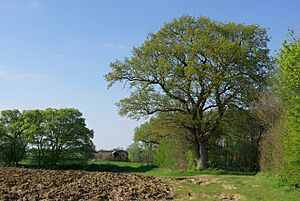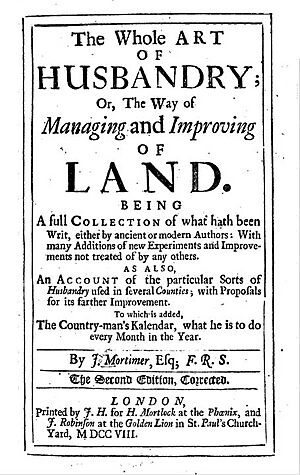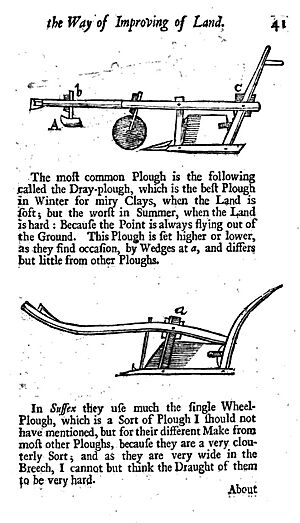John Mortimer (agriculturalist) facts for kids
John Mortimer (born around 1656 – died 1736) was an English merchant and writer. He is best known for his important book on farming, The whole Art of Husbandry, in the way of Managing and Improving of Land, which came out in London in 1707.
Contents
About John Mortimer
John Mortimer was born in 1656. He was the only son of Mark Mortimer, a grocer from London. John grew up and received a business education, becoming a successful merchant in London.
In November 1693, when he was about 43, John bought a large estate called Topping Hall in Hatfield Peverel, Essex. He worked hard to improve this land. Some cedar trees he planted were still there many years later! In December 1705, he became a Fellow of the Royal Society, which is a group of important scientists and thinkers.

John Mortimer was married three times. His first wife, Dorothy, was the daughter of Richard Cromwell, who used to be a very powerful leader in England. Dorothy passed away in 1681. John then married Sarah, and they had a son and a daughter. His third wife was Elizabeth, and they had four sons and two daughters. One of his sons was Cromwell Mortimer.
His Books
Besides his famous farming book, John Mortimer also wrote other books:
- Some Considerations concerning the present State of Religion (1702), which was about bringing people together.
- Advice to Parents, or Rules for the Education of Children (1704), which gave tips on raising kids.
- And, of course, The whole Art of Husbandry in 1707.
The whole Art of Husbandry, 1707
John Mortimer's book, The whole Art of Husbandry, was a very important book about farming in England. It greatly influenced how people farmed in the 1700s. Mortimer said he had read the best books on farming from ancient times and his own time. He also looked at how the best farmers worked in different places. He then added his own experiences to create his book.
The book covered many topics. It wasn't just about growing crops, but also about fish ponds, orchards, raising silkworms, and making cider. Experts like John Donaldson (writing in 1854) said that Mortimer's book was a big step forward in farming knowledge. It talked more about animals and treated them in a more organized way than earlier books.
Mortimer dedicated his book to the Royal Society. The book was so popular that new versions came out in 1708 and 1712. The 1712 edition even included a "Kalendar" showing what to do each month in the flower garden. The book was also translated into Swedish in 1727. A sixth edition, with updates by his grandson Thomas Mortimer, was published in 1761.
What was in The whole Art of Husbandry?
The whole Art of Husbandry was a big book with 15 main sections, called "books." Each book had many chapters about related topics.
For example, the first book talked about fencing off land, improving pastures and meadows, making hay, and different kinds of grass seeds like clover and lucerne. The second book discussed how to prepare land for planting, different types of ploughs, and how to sow seeds.
The fourth book had many chapters about how to make land better for growing crops. This included using different kinds of manure (like from animals), burning land, and adding things like chalk, lime, marl, and even seaweed.
Other books covered topics like:
- Different types of grains and pulse crops.
- Animals, fowls, and insects on the farm.
- Pests that could harm the farm.
- How to use corn and make malt.
- Small farming tools.
- Building and repairing farm structures.
- Different kinds of trees and coppice woods.
- Plants for the kitchen garden and fruit trees.
- Making English liquors like ale and cyder.
Mortimer gave practical advice. For instance, he suggested how much agricultural lime to use on land. He also talked about growing Turnips, which were sown in midsummer and provided food for sheep and cows through winter. He noted that flies and caterpillars could sometimes destroy turnip crops.
He also described what good farm animals should look like:
- A good bull should have a sharp look, a broad forehead, black eyes, and a strong body.
- A good cow should have a broad forehead, black eyes, a large belly, and a big udder with four teats.
- A good ram (male sheep) should have a large, long body and cheerful eyes.
- A good ewe (female sheep) should have a broad back, thick wool, and clean, nimble legs.
Mortimer's observations on raising and managing sheep were very smart and are still similar to how sheep are managed today.
His Legacy
John Mortimer was seen as one of the most important farming experts of his time. A famous British book called The Complete Farmer: Or, a General Dictionary of Husbandry, first published in the mid-1700s, listed him among the top agricultural writers.
However, by the late 1700s, Mortimer's influence started to fade a bit as new farming ideas came along. Still, in 1825, John Claudius Loudon confirmed that Mortimer's book was very important in the 18th century. Loudon noted that not much changed in farming practices in England until near the end of the 1700s, and Mortimer's book from 1706 was a key guide.
Donaldson, in 1854, gave credit to Mortimer for being one of the first writers to cover all parts of farming in one book.
Selected Publications
- John Mortimer. Some Considerations concerning the present State of Religion, with some Essays towards our Love and Union, London, 1702.
- John Mortimer. Advice to Parents, or Rules for the Education of Children, London, 1704.
- John Mortimer. The whole Art of Husbandry, in the way of Managing and Improving of Land. London, 1707.



